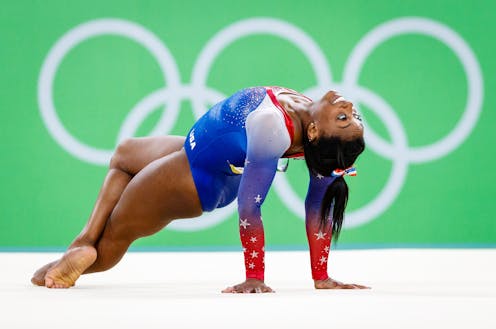
In elite gymnastics, few names shine as brightly as Simone Biles, known for her high difficulty routines and seemingly unshakeable confidence. Biles stunned the world during the Tokyo Olympics when she experienced a bout of what she called “the twisties.”
This phenomenon, where gymnasts lose their spatial awareness mid-air, can turn a well-rehearsed sequence into a perilous plunge. From a psychological perspective, the twisties highlight how a shift in focus from performance to fear and anxiety can derail even the most experienced athletes.
Imagine an athlete at the peak of their career, executing complex routines with precision. Suddenly, an insidious doubt creeps in. Their mind, once a finely tuned machine of muscle memory and instinct, becomes a battlefield of overthinking and fear.
Known as the twisties in gymnastics and diving, the yips in golf and cricket, choking in basketball, target panic in archery and precision sports, and generally perceived as a mental block, this is a deeply rooted psychological issue where task focus shifts to anxiety.
In Biles’ case, the twisties manifested as a terrifying inability to sense her body’s position while airborne. Psychologically, this happens when an athlete’s attention shifts from performing a well-rehearsed skill to the potential consequences of failure.
The onset of the twisties is recognising that “something” isn’t right. The brain, trying to find the “right moment”, shifts away from the automatic processes essential for high risk manoeuvres and the athlete instead develops a heightened awareness of their thoughts. Searching for that moment to exit a spin, release a ball, or fire an arrow, pulls the athlete out of the automatic flow state, which leads to overthinking and, ultimately, a significant dip in performance.
The longer this search continues, the more likely it is that this cognitive shift increases somatic anxiety, when physical symptoms like increased heart rate and muscle tension further impede performance.
Table of Contents
Treating the twisties
After the Tokyo Olympic Games, in an interview with Cosmopolitan magazine, Biles candidly shared: “I was so nervous about getting injured physically that I kind of neglected my mental health.” This revelation revealed the importance of well being in high-performance sports. To overcome her struggles, Biles began therapy, joining many athletes who address their mental health by working with psychologists. These professionals use scientific techniques to optimise thinking and performance, helping athletes stay ahead of the demanding world of elite competition.
If you’ve experienced a mental block, it’s safe to say that you can get through it and the experience will make you better. Rebuilding takes time, reflection, and when you’re ready, a mental model that fits how you work. That’s where psychologists excel, in helping develop this mental scaffolding to manage thinking, especially when under pressure.
Building a mental model
Mental models or performance routines are structured ways to manage thinking, usually involving three phases that help athletes refocus attention, plan and commit to action.
To refocus attention, athletes use pre-planned cues such as a deep breath out or a slow sip of water. The rationale behind cues, particularly the deep breath out, lies in their ability to shift the body from a sympathetic state (characterised by racing thoughts, and an elevated heart rate and cortisol levels) to a parasympathetic state, which mitigates anxiety. In addition, cues activate the next step – planning through the use of imagery.
In my work with Olympic athletes, we explore a variety of performance scenarios using multi-sensory imagery: the sounds of the crowd, the smell of the track, the movements as you compete, colours, sights, and the strategies for controlling emotions. This process develops familiarisation and evokes motivation.
The model concludes with a commitment behavioural cue, such as self-talk or a leg tap. For instance, during the Paris Olympics, you might have observed Biles mental model in action before the Balance Beam. She takes in a deep breath to refocus attention, plans by imagining her routine (we know this because her body is moving as she plays out what’s about to happen), and uses a commitment cue to affirm: “You got this!”
The path to excellence
The twisties, the yips, and similar phenomena reveal an important truth about elite athletes: they experience mental blocks precisely because they know what great performance feels like, and they struggle to find that perfect moment. However, these mental blocks can be overcome with the right training, support and techniques.
When incorporating performance routines, athletes can prepare for the pressures they face, developing their ability to perform under stressful situations and events.
As we watch athletes like Simone Biles push the boundaries of human capability, they reminds us of the power of the mind and the importance of healthy high performance. Their stories inspire us to recognise that excellence is not just about physical ability but also about mastering the mental game. Whether on the balance beam or in our daily lives, understanding and overcoming mental blocks can lead us to our own moments of greatness.
![]()
Jonathan Rhodes does not work for, consult, own shares in or receive funding from any company or organisation that would benefit from this article, and has disclosed no relevant affiliations beyond their academic appointment.



























